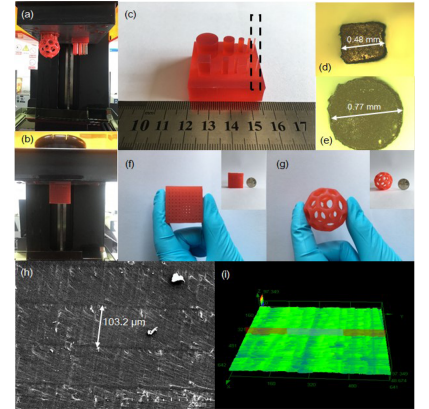
Parts 3D printed with the soybean oil resin. Image Credit: Guangdong University of Technology.
A new soybean-based resin for on-demand 3D printing could offer strength, flexibility, and renewability.
As 3D printing becomes more and more important, and commonplace, the need for reliable, strong, and renewable materials to utilize this on-demand manufacturing process soars. The question is; how to make 3D printing viable and inexpensive.
Material scientists from the Guangdong University of Technology may have found a solution in the unlikely form of vegetable oil. The team has produced a vegetable oil-based photopolymer resin for stereolithography (SLA) 3D printing, which has high tensile strength, flexibility, and is still biodegradable, with a mix of soybean oil (SBO-URE) and urethane epoxy and acrylates. Their research is published in the journal I&EC Research.
The fact that the resin created by the researchers is biological in nature and thus renewable is vital for establishing a circular economy and making SLA 3D printing, which has a wide range of uses not just in manufacturing and industry, but also in medicine, more economical and thus more viable. It also eliminates a long-stand issue with 3D printing materials, the trade-off between strength and pliability.
3D Printing, Renewability, and Flexibility
The search for an environmentally friendly material for use in SLA 3D printing is a rapidly emerging focus in materials research. This means the exploration of renewable bio-based resins, including cellulose-based polymers and vegetable oil-based acrylates. But as well as being renewable, the use of vegetable oil solves a problem that exists with materials currently used in 3D printing.
Photosensitive liquid resins that are currently used for SLA 3D printing are generally composed of liquid monomers, oligomers, and photoinitiators which grant high resolution, smooth part surfaces, good layer strength, and fast building speed. They also deliver impressive mechanical strength and stiffness.
But, what these materials fail to deliver is flexibility. This means that parts created with these substances can often break and crack after serving only a short service life. Thus, strategies to introduce some flexibility to these products is highly desirable. Many different solutions have been offered and studied, but vegetable products offer the ideal solution.
Yet again, there’s a hitch to this. Introducing vegetable oils via blending with other functional materials can result in a loosening of the networks which form the basis of the materials and thus cause a loss of mechanical strength. Because of this drawback, bio-based 3D printing is scarce.
Best of Both Worlds: Delivering Strength and Flexibility
In order to deliver their ‘best of both worlds’ flexible and strong resin, the team took a synthesized SBO-URE solution based upon their previous work. They then converted the carbon-carbon double bonds in this material into epoxides — cyclic ethers with three-atom rings that resemble equilateral triangles — thus creating their dual-curing hybrid resin. They then used this resin to create products to test.
This dual-cured material has significant benefits over single cured resins, with initial curing creating a solid physical layer for the product, and the second curing boosting its mechanical properties by creating a denser cross-linked network structure — thus reinforcing it. This grants the product of the printing process a significant toughness boost.
The next step was stringent testing, with the team subjecting the parts they created to a gruelling barrage of mechanical stress tests, including stretching the part, elongating it to breakpoint. In the process, the researchers found that adding additional SBO-URE to the epoxy acrylate actually increased tensile strength without any loss of flexibility. In other words, under elongation, the breaking point was the same.
Thus, the team’s results show that the addition of soybean oil can significantly boost mechanical strength at zero cost to a 3D printed part’s flexibility due to the creation of an interwoven structure and the incorporation of long flexible organic carbon and hydrogen chains.
As a result, the researchers may have delivered a tough, flexible, and renewable material prime for 3D printing — creating bright new possibilities for the crafting of custom made, on-demand parts for areas as diverse as manufacturing, surgery, density and a wide-host of other applications.
References
Chu. Y, Yang. J, Lei. D, Su. J, [2020]. ‘3D Printing of a Dual-Curing Resin with Cationic Curable Vegetable Oil,’ I&EC Research, [https://pubs.acs.org/doi/10.1021/acs.iecr.0c01507].
Disclaimer: The views expressed here are those of the author expressed in their private capacity and do not necessarily represent the views of AZoM.com Limited T/A AZoNetwork the owner and operator of this website. This disclaimer forms part of the Terms and conditions of use of this website.